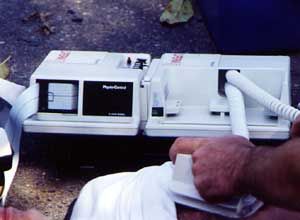In each decade of our profession’s young history, there have been one or two products that cast a long shadow across the EMS landscape.
I’ve made a list of the dozen that I think have had the biggest impact on our industry. Most were not the first device of their type, but they were often the first ones that worked well and held up in the field. They were the ones that succeeded in bringing large scale change to EMS practice.
Many of these or their direct descendants are still in production today. That says a lot about their longevity and acceptance by EMS professionals across America.
So, without further ado, the 12 Most Important Products in the short History of EMS:
 Resusci Anne/Photo Laerdal |
1. In the 1960’s it was the Resusci Anne from Laerdal Medical. Resusci Annie made large scale CPR training possible. You cannot understate the impact it had on teaching the science of cardiac resuscitation to hundreds of thousands.
2. In the 1970’s, the Hare Traction splint changed how femur fractures were treated across the country. It dramatically reduced morbidity and mortality for the first time, integrating a windless and long leg splint into a single convenient device.
3. The Kendrick Extrication Device allowed rapid extrication without spinal compromise. Until then, short spine boards were mostly homemade affairs. They relied on long 9' straps, and the skills of rigger.
4. The Laerdal Pocket Mask made mouth to mask possible on a broad scale. They ultimately became as common as trauma scissors. They still save lives from simple respiratory arrest every day. They helped rescuers overcome the reluctance to perform mouth-to-mouth, and could supplement oxygen significantly.
5. The Laerdal Stifneck Extrication Collar became another game-changing EMS product. Before their prominence, patients were immobilized using soft rehab collars, if anything at all. With a properly fitted Stiffneck, almost anyone’s C-spine could now be immobilized. Combined with the aforementioned KED, they changed how we did auto extrication.
6. The Ferno 35-A Mobile Transporter was the first X-frame self-loaded stretcher. It was able to roll into many ambulances of the day. Those that it couldn’t were soon changed — it was that influential. Many went from ambulance stretchers, like the Model 30 that you had to pick up to load, to the 35-A. This did more to contribute to reducing EMS personnel injuries than any other single improvement of the decade.
 Lifepak 5/Photo Physio-Control |
7. The Physio-Control Lifepak 5 was the first truly portable cardiac monitor and defibrillator. It became the gold standard by which others were judged for at least 20 years. Before its invention, you needed to be pretty fit to carry a defibrillator; some weighed up to 40 pounds.
8. The Nonin 8500 Pulse Oximeter was the first handheld field pulse oximeter. It was also the first reliable piece of medical diagnostics other than the defibrillator. When first introduced, SAO2 was little known or appreciated. Now it has become virtually a fifth vital sign, and on nearly every patient chart.
9. The ProLite Spineboard was not the first plastic backboard. But it was the first really good one, which made the plastic backboard popular. Its three-part combination of foam-filled low density polyethylene with carbon fiber plastic rods proved to be a breakthrough. In a few short years most ambulances switched from wooden spine boards to plastic.
10. The Phillips Heartstart AED was the first rugged and commercially popular AED designed to be easy to use, with simple and intuitive control buttons. It’s found in nearly every type of first response agency and public setting. It helped turn AED’s into a practical public appliance.
11. The Stryker Power-PRO ambulance stretcher wasn’t the first power cot, but it was the first one that really worked and made power cots popular. The technology gets at the root of many of the previously unmanageable EMS worker injuries.
12. The first Ambu Bag was a black rubberized reusable affair. While popular, it was eclipsed by the popularity of the disposable Ambu Spur. Today, the product has become so ubiquitous that users call almost every brand of bag-valve mask resuscitator an “Ambu Bag.”
That rounds out the short list. There are many others I wish I could have included. Maybe one day I’ll expand it to the Top Two Dozen.
Until then, I welcome your comments and or corrections. What do You Think were the 12 Most Important Products in the modern history of EMS?












